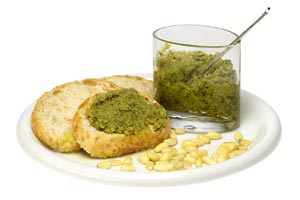In a cooking rut? Try one of these taste-tested, family-approved recipes using ground beef.

Pesto is a versatile sauce that can be used in a variety of dishes. Pesto is traditionally made using a mortar and pestle, but now it is more commonly made in a food processor.

12 shelled walnuts
2 tablespoons pine nuts
1 teaspoon coarse salt
5 black peppercorns
3 cloves garlic
4 tablespoons butter, softened
3 cups fresh basil leaves
4 ounces grated Parmesan cheese
4 ounces grated Romano cheese
1 1/2 cup olive oil
Combine the walnuts, pine nuts, salt, peppercorns, garlic, butter, basil, Parmesan, and Romano cheeses in a food processor. Pulse process until ground.
With the food processor running, slowly add the olive oil through the feed tube until the pesto is smooth and blended.
Store the pesto in an airtight container in the refrigerator for up to 1 week.
In a cooking rut? Try one of these taste-tested, family-approved recipes using ground beef.
Ah, the unassuming envelope of onion soup mix. It's more than just for onion soup (or dip). It adds tremendous flavor (and convenience) in all these recipes.
Pizza night is always a favorite, especially when you have great tasting pizza from some of the most popular restaurants.

Online since 1995, CDKitchen has grown into a large collection of delicious recipes created by home cooks and professional chefs from around the world. We are all about tasty treats, good eats, and fun food. Join our community of 200K+ members - browse for a recipe, submit your own, add a review, or upload a recipe photo.

reviews & comments
November 30, 2006
This is a good recipe, very close to the "real" thing as one would find in Liguria, where basil pesto originated. It should be noted that if you want the most authentic pesto possible (I know there are many variations even in Italy), you might consider using the much milder Pecorino Toscano instead of (Pecorino) Romano. And use less Parmigiano, since the Genovese are much less likely to use the Romano and (expensive) parmigiano. A squeeze of lemon helps keeps the Pesto green, and is found in many Italian family recipes.
September 2, 2004
This is a very good recipe and scales quite well. However, I'd like to point out that the walnuts/pinenuts should be added AFTER the basil/ingredients have been lightly blended. The idea is to use the food processor like a mortar/pestile and NOT make a smooth creamy paste, but a more rougher chunky one. This makes a much more "original" pesto, with some real depth. There should be bits of leaves and small pieces of nuts visible when you're done.